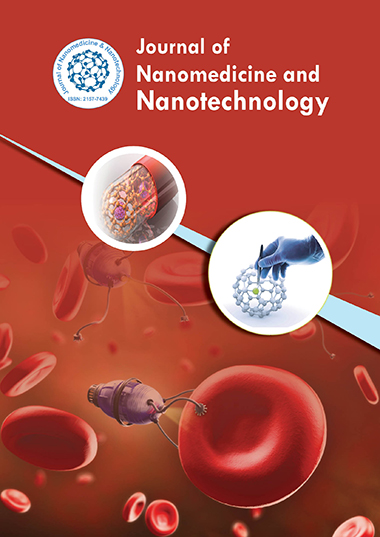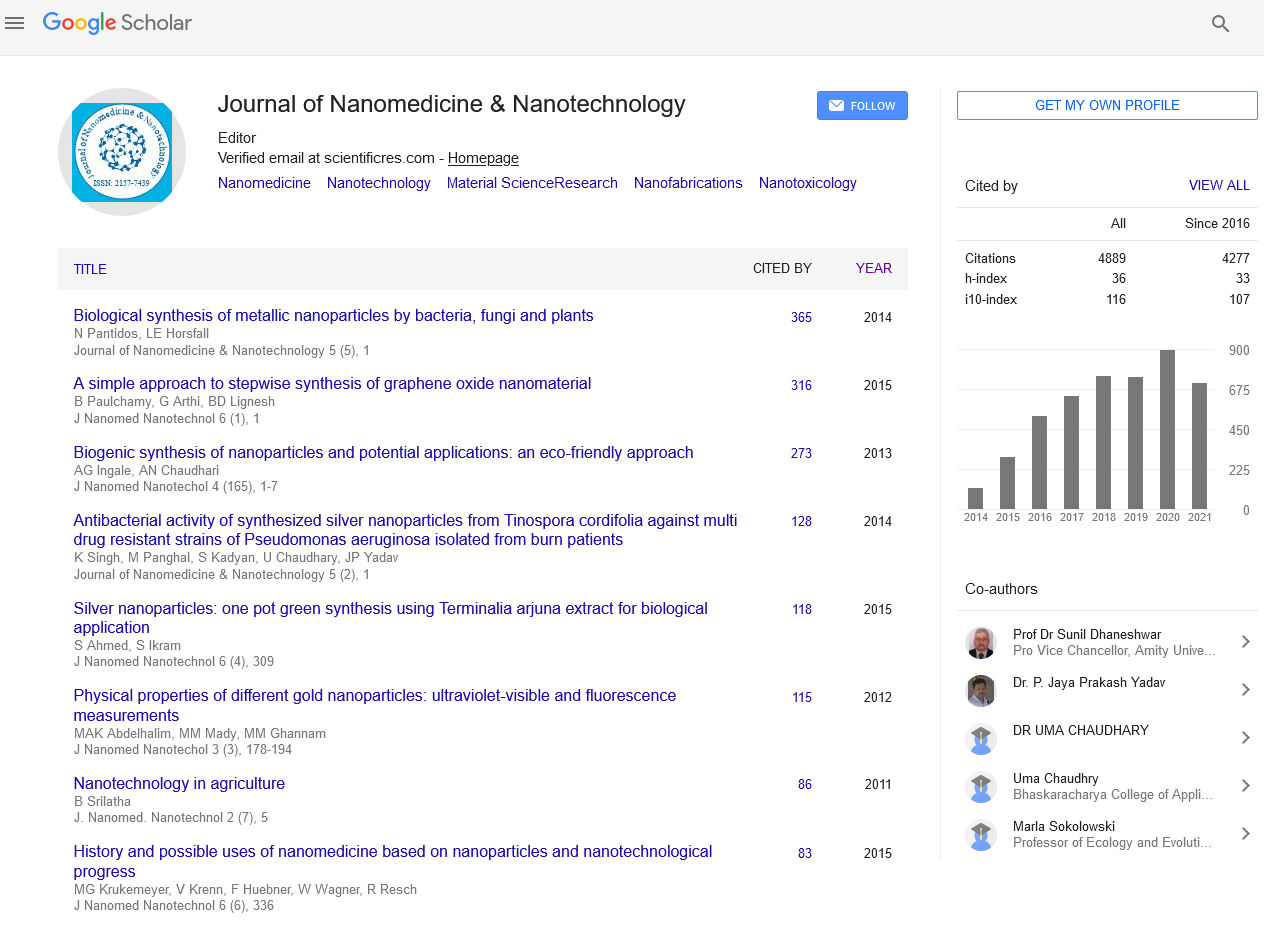Indexed In
- Open J Gate
- Genamics JournalSeek
- Academic Keys
- JournalTOCs
- ResearchBible
- China National Knowledge Infrastructure (CNKI)
- Scimago
- Ulrich's Periodicals Directory
- Electronic Journals Library
- RefSeek
- Hamdard University
- EBSCO A-Z
- OCLC- WorldCat
- SWB online catalog
- Virtual Library of Biology (vifabio)
- Publons
- MIAR
- Scientific Indexing Services (SIS)
- Euro Pub
- Google Scholar
Useful Links
Share This Page
Journal Flyer

Open Access Journals
- Agri and Aquaculture
- Biochemistry
- Bioinformatics & Systems Biology
- Business & Management
- Chemistry
- Clinical Sciences
- Engineering
- Food & Nutrition
- General Science
- Genetics & Molecular Biology
- Immunology & Microbiology
- Medical Sciences
- Neuroscience & Psychology
- Nursing & Health Care
- Pharmaceutical Sciences
Editorial - (2024) Volume 15, Issue 5
Nanodrugs: Transforming the Pharmacokinetics of Therapeutics
Ethan Brown*Received: 03-Sep-2024, Manuscript No. jnmnt-24-27134; Editor assigned: 05-Sep-2024, Pre QC No. jnmnt-24-27134 (PQ); Reviewed: 20-Sep-2024, QC No. jnmnt-24-27134; Revised: 24-Sep-2024, Manuscript No. jnmnt-24-27134 (R); Published: 30-Sep-2024, DOI: 10.35248/2157-7439.24.15.757
Abstract
Nanotechnology has emerged as a transformative approach in the field of drug delivery, significantly improving the pharmacokinetics of therapeutic agents. This article reviews the development and application of nanodrugs, focusing on how they enhance drug solubility, bioavailability, and targeted delivery. We discuss various nanocarrier systems, their mechanisms of action, and clinical applications, particularly in oncology and chronic diseases. Future directions in nanodrug development are also highlighted, emphasizing the potential for personalized medicine.
Keywords
Nanodrugs; Pharmacokinetics; Drug Delivery; Bioavailability; Cancer Therapy; Nanocarriers; Personalized Medicine
INTRODUCTION
The pharmacokinetics of therapeutic agents how drugs are absorbed, distributed, metabolized, and excreted—plays a crucial role in determining their efficacy and safety. Traditional drug formulations often suffer from poor solubility, low bioavailability, and systemic toxicity. Recent advancements in nanotechnology have led to the development of nanodrugs, which leverage nanoscale materials to enhance the pharmacokinetics of therapeutic agents [1]. This article reviews the innovations in nanodrug formulations, highlighting their mechanisms of action and clinical applications.
THE ROLE OF NANOTECHNOLOGY IN DRUG DELIVERY
Nanotechnology involves manipulating materials at the nanoscale (1-100 nm) to create novel drug delivery systems. These nanocarriers can encapsulate therapeutic agents, improving their stability, solubility, and absorption. Several types of nanocarriers are utilized, including liposomes, micelles, dendrimers, and nanoparticles made from metals or polymers. Each type has unique properties that can be tailored for specific therapeutic applications [2].
Liposomes
Liposomes are lipid-based vesicles that can encapsulate both hydrophilic and hydrophobic drugs. Their biocompatibility and ability to mimic cell membranes make them suitable for drug delivery. The encapsulation of drugs in liposomes enhances their solubility and prolongs circulation time in the bloodstream [3]. For example, liposomal formulations of doxorubicin, such as Doxil, have been shown to improve therapeutic outcomes in breast cancer by reducing cardiotoxicity and enhancing drug accumulation in tumors.
Micelles
Micelles are formed by the self-assembly of amphiphilic surfactants in aqueous environments. They can solubilize poorly water-soluble drugs, enhancing their bioavailability. Micelles can be designed to release their payload in response to specific stimuli (e.g., pH changes), further improving their therapeutic efficacy [4]. Research has shown that micellar formulations of paclitaxel can significantly enhance its solubility and therapeutic effect in ovarian cancer treatment.
Dendrimers
Dendrimers are branched, synthetic macromolecules that allow for precise control over size and functional groups. Their unique structure provides high drug-loading capacity and the ability to target specific cells through surface modifications. Dendrimers have been explored for delivering nucleic acids and small molecules, demonstrating potential in gene therapy and cancer treatment.
Inorganic Nanoparticles
Inorganic nanoparticles, such as gold, silica, and iron oxide nanoparticles, offer unique optical and magnetic properties that can be utilized in drug delivery. These nanoparticles can be functionalized with targeting ligands to enhance specificity towards diseased cells [5]. For instance, gold nanoparticles can be used for photothermal therapy, where localized heating can enhance the efficacy of co-delivered chemotherapeutic agents.
ENHANCING PHARMACOKINETICS WITH NANODRUGS
Improved Solubility
Many therapeutic agents, particularly anticancer drugs, have poor water solubility, leading to limited bioavailability. Nanodrug formulations significantly enhance solubility through the encapsulation of drugs in nanocarriers. This improvement enables higher plasma concentrations and enhanced therapeutic effects [6]. For example, the nanocrystallization of poorly soluble drugs like curcumin has demonstrated significantly improved solubility and bioavailability.
Targeted Delivery
Nanodrugs can be engineered for targeted delivery, minimizing systemic exposure and enhancing drug accumulation at the site of action. This is achieved through passive targeting via the enhanced permeability and retention (EPR) effect in tumors or active targeting by conjugating ligands to nanocarriers that bind specifically to cancer cell receptors. Studies have shown that targeted nanodrugs can significantly improve therapeutic outcomes in various cancers while reducing side effects.
Sustained Release
Nanodrugs can provide controlled and sustained release of therapeutic agents, leading to prolonged therapeutic effects and reduced dosing frequency. This is particularly beneficial in chronic diseases, where maintaining steady drug levels can improve patient compliance [7]. For instance, polymeric nanoparticles have been developed to release drugs in response to physiological conditions, allowing for site-specific therapy and reducing systemic toxicity.
Enhanced Bioavailability
The combination of improved solubility, targeted delivery, and sustained release contributes to the overall enhancement of bioavailability for nanodrugs. Increased bioavailability ensures that a greater proportion of the administered drug reaches the systemic circulation and exerts its therapeutic effect. For instance, lipid-based nanoparticles have been shown to significantly increase the bioavailability of poorly soluble drugs such as fenofibrate and ketoprofen [8].
CLINICAL APPLICATIONS OF NANODRUGS
Cancer Therapy
Nanodrugs have shown tremendous promise in oncology, where targeted delivery can significantly improve the therapeutic index of chemotherapeutic agents. Several nanodrug formulations, such as Abraxane (paclitaxel albumin-bound nanoparticles) and Doxil, are already in clinical use. These formulations not only enhance drug delivery to tumors but also reduce off-target effects, resulting in improved patient outcomes [9].
Cardiovascular Diseases
Nanotechnology has also been explored for delivering therapies in cardiovascular diseases. For instance, nanoparticles can be used to deliver anti-inflammatory agents to atherosclerotic plaques, potentially preventing plaque rupture and subsequent heart attacks. Research into nanodrug delivery systems for cardiovascular applications is ongoing, with promising preliminary results.
Chronic Diseases
In chronic diseases such as diabetes and arthritis, sustained release of therapeutic agents through nanodrugs can significantly improve patient compliance and treatment outcomes. Nanoparticles can deliver anti-diabetic agents, hormones, or immunomodulatory drugs in a controlled manner, allowing for better disease management.
FUTURE DIRECTIONS
Despite the advancements in nanodrug technology, several challenges remain, including regulatory hurdles, manufacturing scalability, and long-term safety. Further research is necessary to establish standardized protocols for the evaluation of nanodrugs and their interactions with biological systems.
Emerging technologies such as machine learning and artificial intelligence can aid in the design and optimization of nanodrugs, facilitating the identification of effective formulations more rapidly. Moreover, the integration of nanotechnology with personalized medicine offers exciting possibilities for developing tailored therapies based on individual patient characteristics and disease profiles [10].
CONCLUSION
Nanodrugs represent a significant advancement in the field of drug delivery, transforming the pharmacokinetics of therapeutic agents. By enhancing solubility, bioavailability, and targeted delivery, nanodrugs improve therapeutic outcomes while minimizing side effects. As research continues to advance, the potential for nanodrugs to revolutionize treatment paradigms in various medical fields becomes increasingly apparent, paving the way for more effective and personalized therapeutic strategies.
REFERENCES
- Li Z, Zhang Y, Fullston D, Shen Y. Advanced carbon-based nanomaterials for tumor photothermal therapy. Nanomaterials. 2021;11(5): 1137.
- Wang Y, Qi X, Lu L, Xu X. Anticancer properties of sulfated chitosan. Biol Trace Elem Res. 2019;192(2): 205-212.
- Li J, Wang X, Zhang T, Wang C, Huang Z, Luo et al . Polypyrrole/chitosan-coated Fe3O4 nanoparticles for MRI-guided photothermal cancer therapy. Biomedical Materials. 2020; 15(4): 045001.
- Sharma N, Baldi A, Garg S. Cyclodextrins: encapsulation of drugs. Critical Reviews in Therapeutic Drug Carrier Systems. 2019; 19(3): 185-208.
- Narayanan N, Sudhakumari C C. Cyclodextrin as a tool in enhanced drug delivery. Polym Renew Resour. 2021;10(2): 77-84.
- Smith, K A, Buhro, W E. Synthesis of surface-stabilized beta-cyclodextrin/gold nanoparticle assemblies. Nanoscale Advances. 2020; 2(2): 527-535.
- Xia Q, Cai Y, Zheng J, Zhang J. Nanomaterials-based photothermal therapy and its potentials in antibacterial treatment. Journal of Controlled Release. 2021; 330: 75-90.
- Narayanan, K B, Sakthivel N. Green synthesis of biogenic metal and metal oxide nanoparticles and their effect on the bioactivity of pharmaceuticals. Journal of Molecular Liquids. 2020; 300: 112202.
- Brown S A, Hansbro, P M, Hansbro, N G. Animal models of asthma: value, limitations and opportunities for alternative approaches. Drug Discovery Today. 2019; 24(1): 206-218.
- Jones, J R, Barrère F, van Blitterswijk, C A. Calcium phosphate ceramics as bone graft substitutes in filling bone tumors. Pharmaceuticals. 2020; 3(3): 125.
Indexed at, Google Scholar, Crossref
Indexed at, Google Scholar, Crossref
Indexed at, Google Scholar, Crossref
Indexed at, Google Scholar, Crossref
Indexed at, Google Scholar, Crossref
Indexed at, Google Scholar, Crossref
Indexed at, Google Scholar, Crossref
Citation: Ethan B (2024) Nanodrugs Transforming the Pharmacokinetics of Therapeutics. J Nanomed Nanotech. 15: 748.
Copyright: ©2024 Ethan B. This is an open-access article distributed under the terms of the Creative Commons Attribution License, which permits unrestricted use, distribution, and reproduction in any medium, provided the original author and source are credited.
Competing interests: The authors have declared that no competing interests exist.


